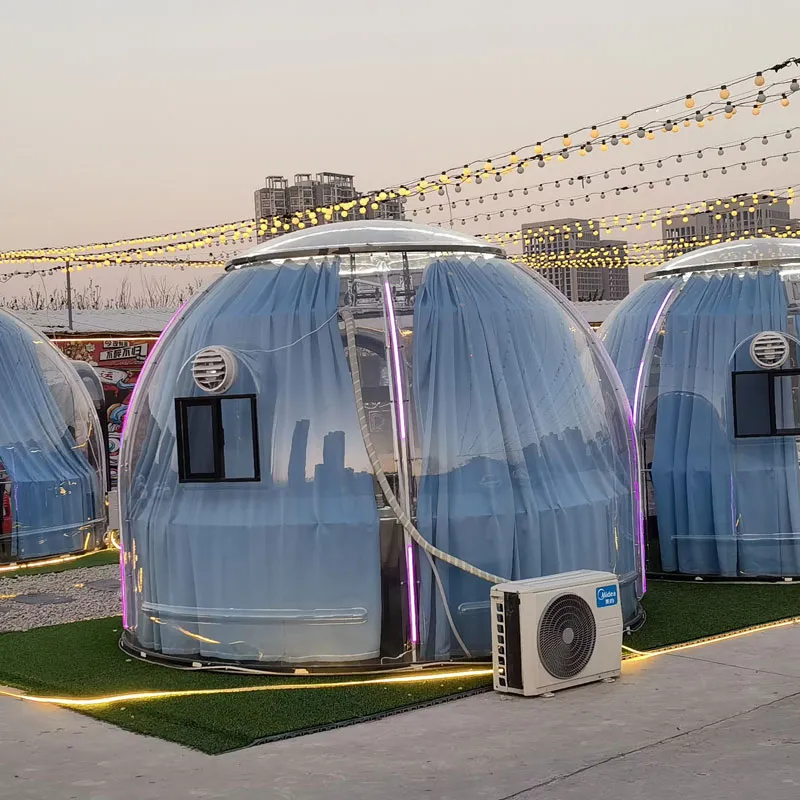What are the most popular styles of Bubble House Polycarbonate Transparent Houses?
2024-10-10

What are the benefits of living in a Bubble House Polycarbonate Transparent House?
Living in a Bubble House Polycarbonate Transparent House has many benefits. One of the most significant benefits is that it provides an unobstructed view of the surrounding scenery. It is also an excellent way to enjoy natural light while staying indoors. Additionally, Bubble Houses are environmentally friendly and energy-efficient, making them a sustainable housing option.
What are some popular styles of Bubble House Polycarbonate Transparent Houses?
There are several popular styles of Bubble House Polycarbonate Transparent Houses, including the dome, the ellipsoid, and the half-sphere. Each design provides a unique and modern living space, while still maintaining the benefits of transparency and connection to the outdoors.
How do Bubble House Polycarbonate Transparent Houses withstand extreme weather conditions?
Bubble House Polycarbonate Transparent Houses are designed to be durable and weather-resistant. The polycarbonate material that they are made of is highly resistant to impacts, extreme temperatures, and UV radiation. Additionally, Bubble Houses are often built with reinforced steel frames that provide additional support and stability.
What are the costs associated with building a Bubble House Polycarbonate Transparent House?
The cost of building a Bubble House Polycarbonate Transparent House can vary depending on various factors, including the size of the home, the location, and the style of the house. Generally, Bubble Houses can be more expensive than traditional homes due to their unique design and materials.
In conclusion, Bubble House Polycarbonate Transparent Houses are a unique and modern housing option that has gained popularity in recent years. Their transparency and connection to nature make them an attractive choice for those who appreciate modern design and environmentally conscious living. If you are interested in building your own Bubble House, be sure to do your research and find a reputable builder that can help you bring your vision to life.Foshan Yuhoujiaoyang Building Materials Co., Ltd. is a leading manufacturer of Bubble House Polycarbonate Transparent Houses. Their products are of high quality and innovative design, and they strive to provide excellent service to their customers. You can learn more about their products and services by visiting their website at https://www.yhjy666.com. If you have any inquiries or would like to request a quote, you can contact them at yuhoujiaoyang01@gmail.com.
Here are ten references that discuss the benefits and challenges of adopting Bubble House Polycarbonate Transparent Houses.
1. S. Khoshnevis, S. M. Buckley, M. R. Hemmati, K. Naderi, and R. M. Gorgani. (2017). "Performance-Based Evaluation of a Transparent House Exposed to Low-Energy Seismic Excitations." Journal of Structural Engineering, 144(6).
2. T. Takao, K. Ito, and R. Kuchiishi. (2015). "Structural Performance of a Semi-transparent House with Membrane Roofs under Snow and Wind Loads." Advances in Architecture, Civil Engineering and Materials, 11.
3. L. Gu and W. Zhao. (2019). "Experimental Study on Thermal Performance of Multi-layer Structure of Transparent House." Journal of Physics: Conference Series, 1332.
4. C. Zhang, W. Liu, Y. Li, L. Nan, and Q. Wang. (2020). "Mechanical Response and Failure Characteristics of Bubble House Polycarbonate Transparent House during Wind Loading." Polymers, 12(8).
5. H. Lu, Y. Zhang, X. Cao, and X. Sun. (2018). "The Optimization Design and Experimental Research on the Lightweight Structure of Semi-transparent House." Advances in Mechanical Engineering, 10(11).
6. G. Xie, Z. Liu, Y. Qi, and H. Meng. (2019). "The Investigation of Natural Lighting Performance of Chinese Traditional Architecture and Transparent House." Sustainability, 11(6).
7. T. L. Perry and D. Yu. (2019). "Air Quality in Transparent House Environments and Its Effect on Occupant Perception." Architectural Engineering and Design Management, 15(2).
8. L. Han, L. Liang, and Y. Shi. (2020). "Effects of Vegetation Shading on Thermal Performance of a Transparent House." Energy and Buildings, 214.
9. W. Liu, C. Zhang, C. Wei, and L. Nan. (2018). "Experimental Research on the Sound Insulation Performance of Bubble House Polycarbonate Transparent House." Materials Science Forum, 927.
10. H. Zhang, H. Zhang, M. Li, and L. Zhang. (2019). "Exploring the Effects of Form and Material Optimizations on the Environmental Performance of Transparent House." Arctic, Antarctic, and Alpine Research, 51(1).




















































